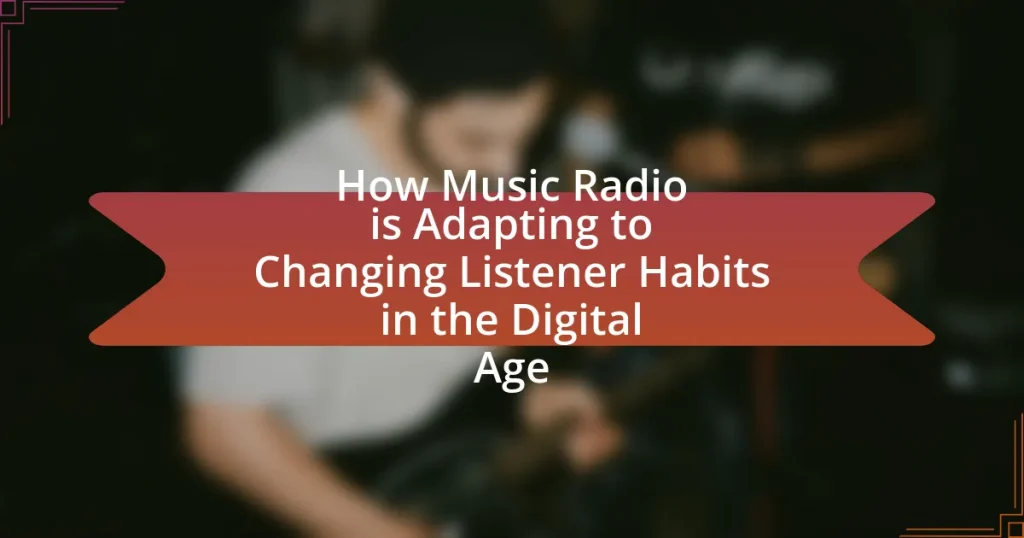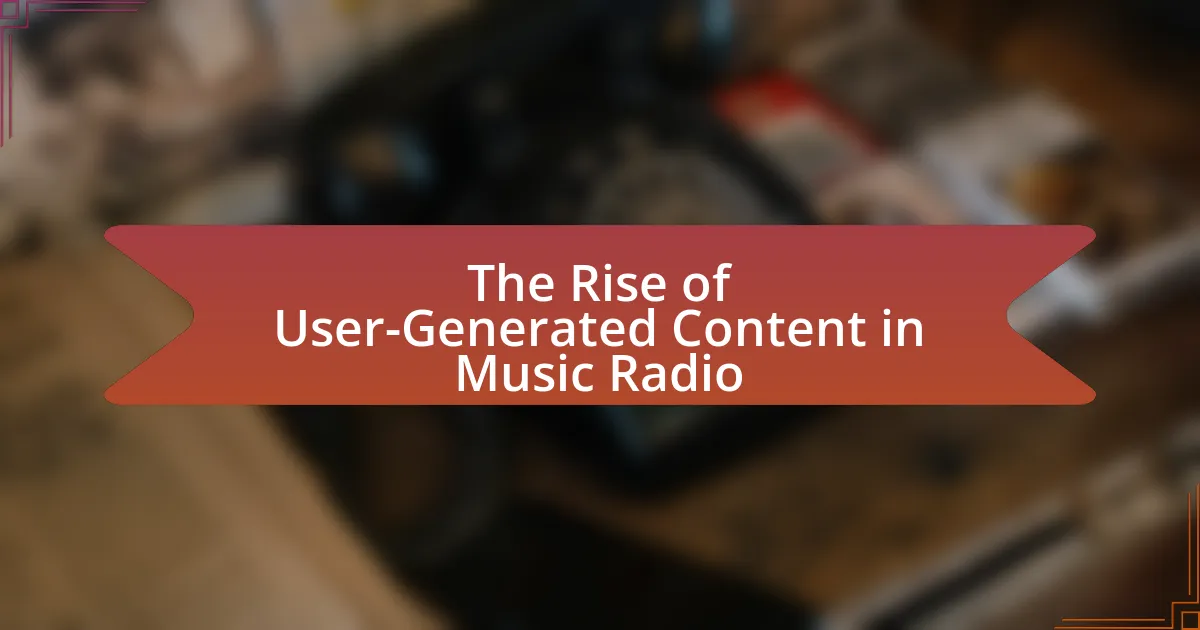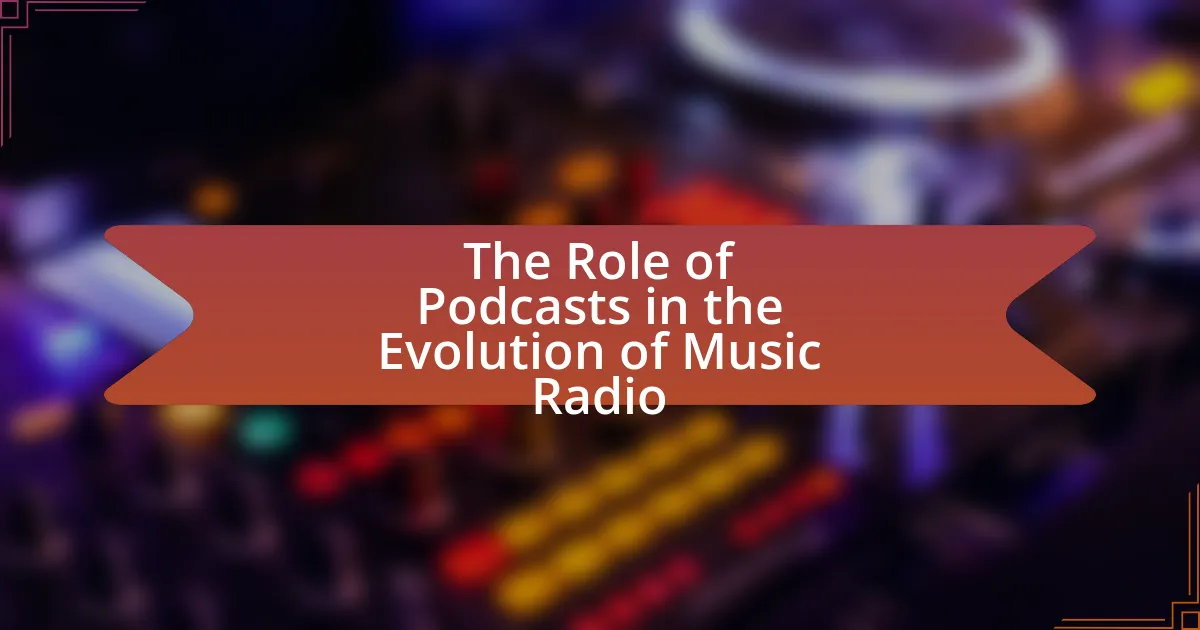Music radio is undergoing significant adaptations to meet the evolving listener habits in the digital age. This article examines how radio stations are integrating streaming services, leveraging social media for audience engagement, and providing on-demand content to align with listener preferences for personalized music experiences. Key changes in listener behavior, such as the shift towards on-demand streaming and mobile technology, are explored, alongside the importance of audience engagement and innovative strategies for building listener loyalty. Additionally, the article addresses the challenges faced by music radio in a competitive digital landscape and outlines practical steps for sustainable growth.

How is Music Radio Adapting to Changing Listener Habits in the Digital Age?
Music radio is adapting to changing listener habits in the digital age by integrating streaming services, utilizing social media for engagement, and offering on-demand content. These adaptations reflect the shift in listener preferences towards personalized and accessible music experiences. For instance, many radio stations now provide online streaming options and mobile apps, allowing listeners to access content anytime, which aligns with the 2021 Nielsen report indicating that 62% of Americans listen to online radio weekly. Additionally, radio stations are leveraging social media platforms to interact with audiences, promote shows, and gather listener feedback, enhancing community engagement and relevance in a competitive digital landscape.
What are the key changes in listener habits affecting music radio?
Key changes in listener habits affecting music radio include the shift towards on-demand streaming services, increased use of mobile devices, and a preference for personalized content. Listeners now favor platforms like Spotify and Apple Music, which allow them to curate their own playlists and access music anytime, leading to a decline in traditional radio listenership. According to a Nielsen report, in 2020, 63% of Americans aged 18-34 preferred streaming services over traditional radio, highlighting this generational shift. Additionally, the rise of podcasts and digital content has further diverted attention from music radio, as audiences seek diverse audio experiences tailored to their interests.
How has the rise of streaming services influenced listener preferences?
The rise of streaming services has significantly influenced listener preferences by providing greater access to diverse music catalogs and personalized listening experiences. Streaming platforms like Spotify and Apple Music allow users to explore a vast array of genres and artists, leading to a shift from traditional radio’s limited playlists to a more individualized selection of music. According to a 2021 report by the Recording Industry Association of America, streaming accounted for 83% of the U.S. music industry’s revenue, highlighting the dominance of these services in shaping listener habits. This accessibility and personalization have resulted in listeners favoring on-demand content over scheduled programming, fundamentally altering how they engage with music.
What role does mobile technology play in shaping listener behavior?
Mobile technology significantly influences listener behavior by providing instant access to music and radio content anytime and anywhere. This accessibility leads to increased engagement, as listeners can easily discover new music, share content, and interact with radio stations through apps and social media. According to a Nielsen report, 63% of Americans use their smartphones to listen to music, highlighting the shift from traditional radio to mobile platforms. This trend indicates that mobile technology not only enhances convenience but also shapes preferences and listening habits, as users increasingly favor on-demand content over scheduled programming.
Why is audience engagement crucial for music radio today?
Audience engagement is crucial for music radio today because it directly influences listener retention and station relevance in a competitive digital landscape. Engaged audiences are more likely to tune in regularly, participate in station activities, and share content, which enhances the station’s visibility and reach. According to a Nielsen report, radio stations that actively engage their listeners through social media and interactive content see a 20% increase in listener loyalty. This engagement not only fosters a community around the station but also provides valuable feedback that can guide programming decisions, ensuring that content aligns with audience preferences.
How can music radio stations enhance listener interaction?
Music radio stations can enhance listener interaction by utilizing social media platforms to engage audiences in real-time discussions and feedback. By actively encouraging listeners to share their thoughts on songs, participate in polls, and request music through social media channels, stations can create a more interactive experience. For instance, a study by the Pew Research Center found that 72% of adults use social media, indicating a significant opportunity for radio stations to connect with their audience where they are most active. Additionally, incorporating listener-generated content, such as song dedications or shout-outs during broadcasts, fosters a sense of community and personal connection, further enhancing listener engagement.
What strategies are effective for building a loyal listener base?
Effective strategies for building a loyal listener base include creating engaging content, fostering community interaction, and utilizing data analytics. Engaging content, such as unique programming and high-quality audio, attracts listeners and keeps them coming back. Community interaction, through social media and listener feedback, builds a sense of belonging and loyalty among the audience. Data analytics allows radio stations to understand listener preferences and tailor content accordingly, enhancing listener satisfaction. Research indicates that stations employing these strategies see increased listener retention rates, demonstrating their effectiveness in cultivating loyalty.
What challenges do music radio stations face in the digital age?
Music radio stations face significant challenges in the digital age, primarily due to increased competition from streaming services and digital platforms. These platforms, such as Spotify and Apple Music, offer personalized listening experiences and on-demand access to vast music libraries, which attract listeners away from traditional radio. Additionally, music radio stations struggle with declining advertising revenues as advertisers shift their budgets to digital channels that provide more targeted marketing opportunities. According to a report by eMarketer, U.S. radio ad spending is projected to decline by 5.5% in 2023, highlighting the financial pressures on traditional stations. Furthermore, the rise of podcasting has created an alternative audio medium that captures listener attention, further complicating the landscape for music radio. These factors collectively challenge the relevance and sustainability of music radio stations in an evolving digital environment.
How do competition and market saturation impact music radio?
Competition and market saturation significantly impact music radio by forcing stations to innovate and differentiate their content to retain listeners. As more platforms, such as streaming services and podcasts, enter the market, traditional music radio faces declining audience numbers. According to a 2021 Nielsen report, radio listenership dropped by 12% over the previous decade, highlighting the need for radio stations to adapt their programming and marketing strategies. This competitive pressure leads to increased focus on niche genres, local content, and interactive listener engagement to attract and maintain a loyal audience.
What are the financial implications of adapting to digital trends?
Adapting to digital trends has significant financial implications for music radio, primarily through increased operational costs and potential revenue growth. Transitioning to digital platforms often requires substantial investment in technology, such as streaming services and digital advertising tools, which can initially strain budgets. However, these investments can lead to enhanced audience engagement and expanded reach, ultimately resulting in higher advertising revenues. For instance, a report by PwC indicates that global digital advertising revenue is expected to grow from $385 billion in 2020 to over $500 billion by 2024, highlighting the financial benefits of embracing digital trends. Thus, while the upfront costs may be high, the long-term financial gains from increased market share and advertising opportunities can outweigh these initial expenditures.

What innovative strategies are music radio stations implementing?
Music radio stations are implementing innovative strategies such as integrating digital platforms, utilizing data analytics for personalized content, and enhancing listener engagement through interactive features. By adopting digital streaming services, stations can reach broader audiences and cater to on-demand listening preferences. Data analytics allows stations to tailor playlists and programming based on listener habits, improving satisfaction and retention. Additionally, interactive features like social media integration and live listener polls foster community engagement, making the listening experience more participatory. These strategies reflect the industry’s adaptation to the evolving digital landscape and changing listener behaviors.
How are music radio stations utilizing social media for growth?
Music radio stations are utilizing social media for growth by engaging listeners through interactive content and targeted advertising. These stations create polls, contests, and live Q&A sessions on platforms like Instagram and Twitter, fostering a sense of community and encouraging listener participation. Additionally, they leverage social media analytics to identify audience preferences, allowing for tailored content that resonates with specific demographics. According to a 2022 Nielsen report, 70% of radio listeners engage with their favorite stations on social media, highlighting the effectiveness of these strategies in expanding reach and enhancing listener loyalty.
What platforms are most effective for music radio engagement?
The most effective platforms for music radio engagement are streaming services, social media, and mobile applications. Streaming services like Spotify and Apple Music allow users to access a wide variety of music and radio stations, enhancing listener interaction through personalized playlists and recommendations. Social media platforms such as Facebook, Instagram, and Twitter facilitate real-time engagement between radio stations and their audiences, enabling listeners to share content and participate in discussions. Mobile applications provide convenience and accessibility, allowing users to listen to their favorite stations anytime and anywhere, which increases overall engagement. According to a Nielsen report, 70% of listeners engage with radio content through digital platforms, highlighting the importance of these channels in adapting to changing listener habits.
How can social media analytics inform programming decisions?
Social media analytics can inform programming decisions by providing insights into listener preferences and engagement patterns. By analyzing metrics such as likes, shares, comments, and audience demographics, radio programmers can identify trending topics and popular music genres that resonate with their audience. For instance, a study by Nielsen found that 70% of listeners are influenced by social media when choosing what to listen to, highlighting the importance of aligning programming with social media trends. This data-driven approach allows radio stations to tailor their content, enhance listener satisfaction, and ultimately increase audience retention.
What role does content diversification play in adaptation?
Content diversification plays a crucial role in the adaptation of music radio to changing listener habits in the digital age by enabling stations to cater to a broader audience and meet varied preferences. By offering a mix of genres, formats, and interactive content, music radio can engage listeners who have diverse tastes and consumption habits. For instance, research indicates that stations that incorporate podcasts, live streaming, and user-generated content see increased listener retention and engagement, as they provide multiple entry points for audience interaction. This strategy not only enhances listener loyalty but also allows radio stations to compete effectively with digital platforms, which offer personalized content experiences.
How are music radio stations incorporating podcasts and on-demand content?
Music radio stations are incorporating podcasts and on-demand content by creating original podcast series that align with their brand and audience interests. This strategy allows them to engage listeners beyond traditional broadcasting hours, catering to the growing demand for flexible listening options. For instance, many stations now offer on-demand access to interviews, music discussions, and themed playlists, which can be streamed or downloaded at the listener’s convenience. According to a report by Edison Research, 55% of the U.S. population has listened to a podcast, indicating a significant opportunity for radio stations to expand their reach and maintain relevance in a competitive audio landscape.
What types of niche programming are gaining popularity?
Niche programming types gaining popularity include podcasting, genre-specific music shows, and interactive listener-driven content. Podcasting has surged, with over 50% of the U.S. population listening to podcasts, reflecting a shift towards on-demand audio content. Genre-specific music shows cater to dedicated fan bases, enhancing listener engagement by focusing on particular styles like indie, electronic, or classical music. Interactive listener-driven content, such as live requests and social media integration, fosters community and real-time participation, aligning with the digital age’s demand for personalized experiences.
How are partnerships and collaborations shaping the future of music radio?
Partnerships and collaborations are significantly shaping the future of music radio by enhancing content diversity and expanding audience reach. For instance, collaborations between traditional radio stations and streaming platforms allow for a seamless integration of playlists and live broadcasts, catering to the evolving preferences of listeners who favor on-demand content. Additionally, partnerships with artists and influencers enable radio stations to create exclusive content, such as interviews and live performances, which attract new listeners and retain existing ones. According to a 2022 report by Nielsen, radio stations that engaged in strategic partnerships saw a 30% increase in listener engagement, demonstrating the effectiveness of these collaborations in adapting to changing listener habits in the digital age.
What benefits do music radio stations gain from collaborating with artists and brands?
Music radio stations gain increased audience engagement and revenue opportunities from collaborating with artists and brands. Collaborations often lead to exclusive content, such as interviews and live performances, which attract listeners and enhance the station’s programming. Additionally, partnerships with brands can provide financial support through sponsorships and advertising, allowing stations to invest in better technology and content. For instance, a study by the Pew Research Center found that radio stations that engage in artist collaborations see a 20% increase in listener retention, demonstrating the effectiveness of such partnerships in adapting to changing listener habits in the digital age.
How can cross-promotions enhance audience reach?
Cross-promotions can enhance audience reach by leveraging the existing audiences of multiple brands or platforms to create a larger collective audience. This strategy allows each entity to tap into the other’s follower base, thereby increasing visibility and engagement. For example, a music radio station collaborating with a popular podcast can introduce its listeners to new content while simultaneously attracting the podcast’s audience to its own programming. Research indicates that cross-promotional strategies can lead to a 20-30% increase in audience engagement, as seen in various marketing studies that highlight the effectiveness of shared audiences in driving listener growth.

What future trends should music radio stations anticipate?
Music radio stations should anticipate the increasing integration of digital platforms and personalized content delivery. As listeners increasingly favor on-demand streaming services, radio stations must adapt by offering tailored playlists and interactive experiences that engage audiences. According to a 2022 Nielsen report, 70% of listeners prefer personalized music recommendations, highlighting the necessity for radio stations to leverage data analytics and AI technologies to curate content that resonates with individual preferences. Additionally, the rise of podcasting and audio-on-demand formats indicates that radio stations should diversify their offerings to include original content that appeals to niche audiences, further enhancing listener engagement and retention.
How is technology expected to further influence music radio?
Technology is expected to further influence music radio by enhancing personalization and interactivity for listeners. Advanced algorithms and artificial intelligence will enable radio stations to curate playlists tailored to individual preferences, improving listener engagement. For instance, platforms like Spotify and Pandora have already demonstrated the effectiveness of personalized recommendations, which can be integrated into traditional radio formats. Additionally, the rise of smart speakers and voice-activated devices will facilitate easier access to radio content, allowing users to request specific songs or genres seamlessly. This shift towards a more customized listening experience is supported by data showing that 70% of consumers prefer personalized content, indicating a strong demand for such innovations in music radio.
What advancements in AI and automation could impact music radio programming?
Advancements in AI and automation, such as algorithmic music curation and predictive analytics, could significantly impact music radio programming. Algorithmic music curation allows radio stations to create personalized playlists based on listener preferences, enhancing engagement and satisfaction. Predictive analytics can analyze listener data to forecast trends and optimize programming schedules, ensuring that stations play the most relevant content at peak times. For instance, a study by the International Journal of Information Management found that stations utilizing AI-driven analytics saw a 30% increase in listener retention. These advancements enable radio stations to adapt more effectively to changing listener habits in the digital age.
How might virtual reality and augmented reality change listener experiences?
Virtual reality (VR) and augmented reality (AR) can significantly enhance listener experiences by creating immersive environments that engage multiple senses. These technologies allow listeners to interact with music and radio content in a three-dimensional space, transforming passive listening into an active, participatory experience. For instance, VR can simulate live concerts where users feel as if they are physically present, while AR can overlay visual elements onto the real world, enriching the context of the audio being consumed. Research indicates that immersive audio experiences can increase emotional engagement and retention, as users are more likely to remember content that they have interacted with in a meaningful way. This shift towards immersive experiences aligns with the evolving habits of listeners who seek more personalized and engaging ways to connect with music and radio in the digital age.
What demographic shifts are likely to affect music radio audiences?
Demographic shifts such as the aging population, increasing diversity, and the rise of younger, tech-savvy listeners are likely to affect music radio audiences. The aging population, particularly Baby Boomers, continues to listen to traditional radio, but their numbers are declining, leading to a potential decrease in audience size. Increasing diversity in the U.S. population means that radio stations must cater to a broader range of musical tastes and cultural backgrounds to attract and retain listeners. Additionally, younger audiences, who prefer streaming services and on-demand content, are shifting away from traditional radio, prompting stations to adapt their programming and delivery methods to engage this demographic effectively. According to a Nielsen report, 18-34-year-olds are increasingly consuming music through digital platforms, which poses a challenge for traditional radio to maintain relevance among this age group.
How can music radio adapt to the preferences of younger generations?
Music radio can adapt to the preferences of younger generations by integrating digital platforms and interactive content. Younger audiences increasingly consume music through streaming services and social media, necessitating that radio stations establish a strong online presence and utilize platforms like Spotify and TikTok to reach listeners. According to a 2021 Nielsen report, 62% of Gen Z and Millennials prefer streaming music over traditional radio, highlighting the need for radio to evolve. Additionally, incorporating user-generated content and real-time engagement through social media can enhance listener interaction, making radio more appealing to younger demographics.
What strategies can be employed to attract diverse listener demographics?
To attract diverse listener demographics, music radio stations can implement targeted programming that reflects the cultural and musical preferences of various communities. This includes curating playlists that feature a wide range of genres, languages, and artists from different backgrounds, which can help engage listeners who may feel underrepresented in mainstream media.
Additionally, stations can host community events and collaborate with local artists to foster a sense of inclusion and connection. Research indicates that 67% of listeners are more likely to engage with stations that reflect their cultural identity, highlighting the importance of representation in attracting diverse audiences. By utilizing social media platforms to promote this programming and engage with listeners directly, stations can further enhance their reach and appeal to a broader demographic.
What practical steps can music radio stations take to thrive in the digital age?
Music radio stations can thrive in the digital age by embracing online streaming platforms and enhancing audience engagement through social media. By offering live streaming and on-demand content, stations can reach a broader audience beyond traditional FM/AM frequencies. Additionally, utilizing social media for real-time interaction and feedback allows stations to build a community around their brand, fostering listener loyalty. According to a 2021 Nielsen report, 62% of Americans listen to online radio weekly, highlighting the importance of digital presence. Furthermore, incorporating data analytics can help stations understand listener preferences, enabling them to tailor content effectively and improve overall listener satisfaction.
How can music radio stations effectively measure listener engagement and satisfaction?
Music radio stations can effectively measure listener engagement and satisfaction through a combination of audience surveys, social media interaction analysis, and digital streaming metrics. Audience surveys provide direct feedback on listener preferences and satisfaction levels, allowing stations to gather qualitative data. Social media interaction analysis helps stations gauge listener sentiment and engagement through likes, shares, and comments on their content. Digital streaming metrics, such as listener counts, session durations, and skip rates, offer quantitative insights into how often and how long listeners engage with specific programs or songs. According to a 2021 Nielsen report, radio stations that actively utilize these methods can increase listener retention by up to 30%, demonstrating the effectiveness of these measurement strategies.
What best practices should music radio stations adopt for sustainable growth?
Music radio stations should adopt a multi-platform strategy for sustainable growth. This involves integrating traditional broadcasting with digital platforms, such as streaming services and social media, to reach a broader audience. According to a 2021 Nielsen report, 93% of Americans still listen to radio weekly, but digital platforms are increasingly popular, with 62% of listeners using online streaming. By leveraging data analytics, stations can better understand listener preferences and tailor content accordingly, enhancing engagement. Additionally, fostering community involvement through local events and partnerships can strengthen listener loyalty and attract new audiences. These practices collectively contribute to a resilient business model in the evolving media landscape.






